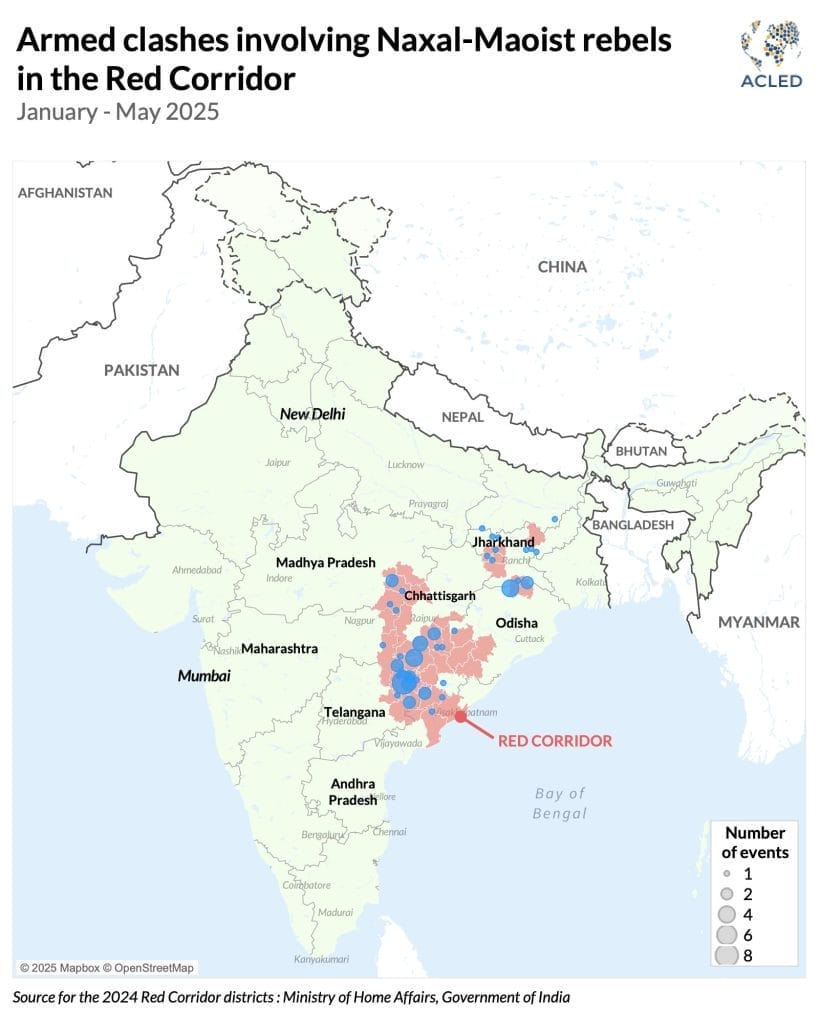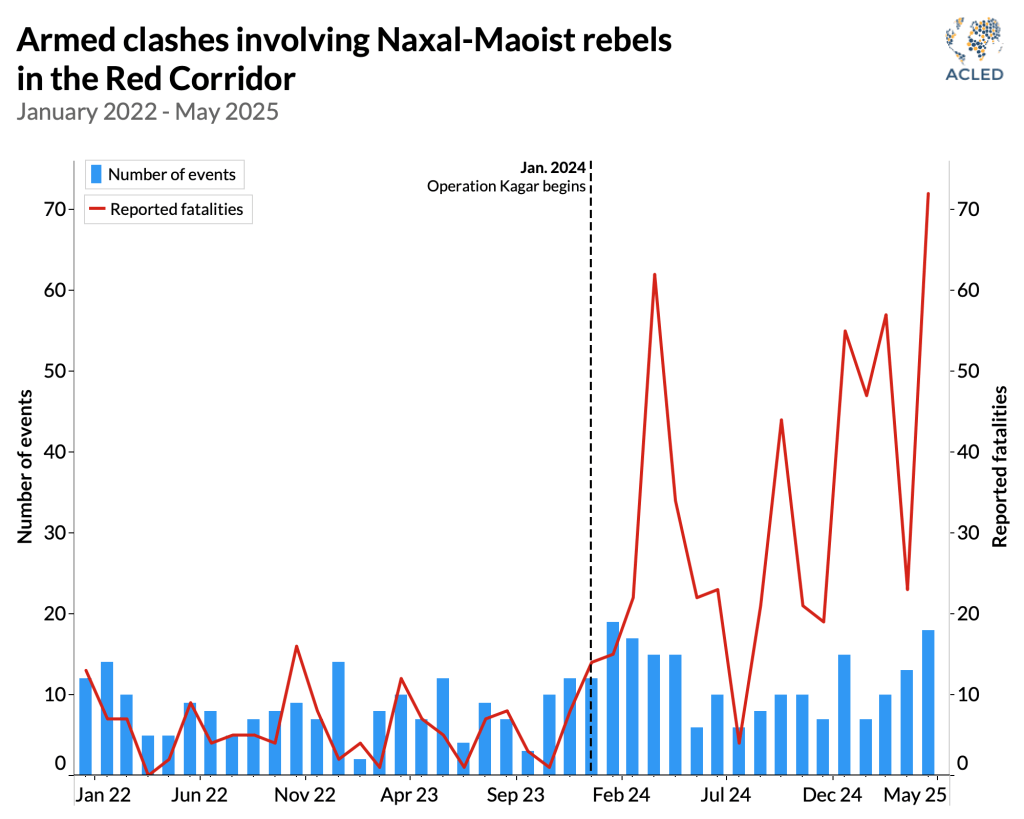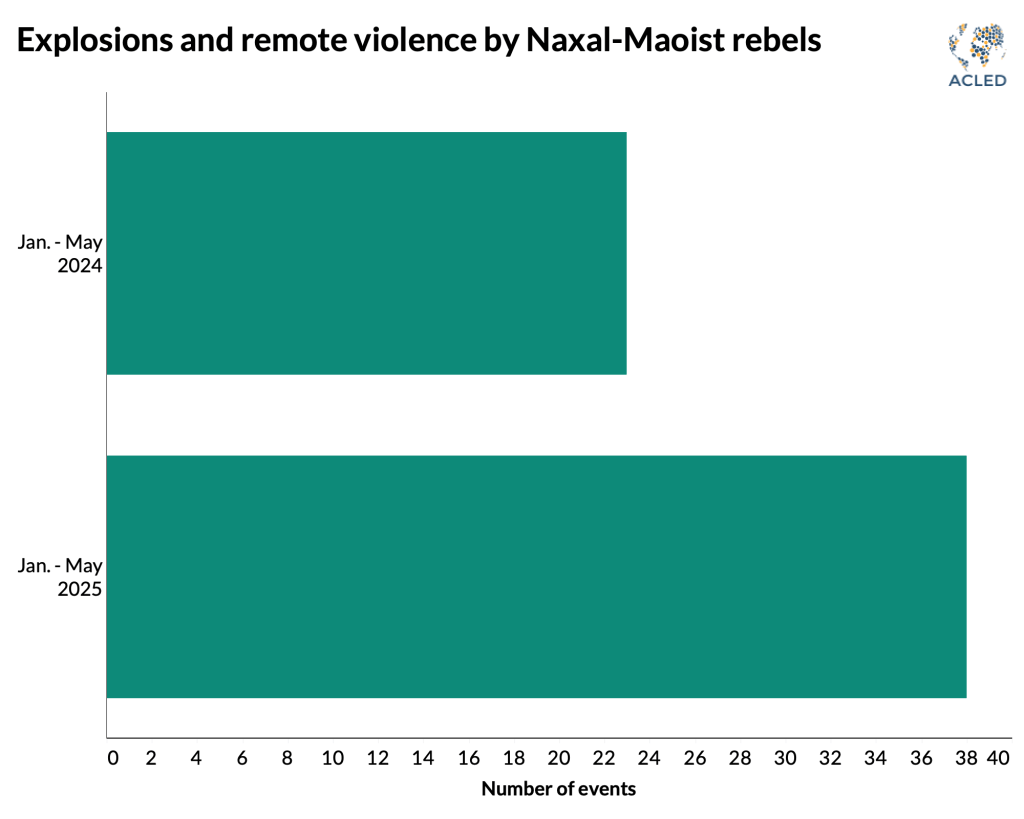Context: As people associated with left-wing extremism are being killed or are surrendering and the forested areas under their control come into the government’s fold, the civilian administration is recalibrating its approach to deliver services in the face of few roads, low Internet connectivity and scattered electricity supply, finds Shubhomoy Sikdar
As far as UPSC CSE mains is concerned, “naxalism” has been a recurring theme.
GS paper III
Linkages between development and spread of extremism.
PYQ: 2022
Naxalism is a social, economic and development issues manifesting as a violent internal security threat. In this context, discuss the emerging issues and suggest a multilayered strategy to tackle the menace of Naxalism.
PYQ: 2018
Left Wing Extremism (LWE) is showing a downward trend, but still affects many parts of the country. Briefly explain the Government of India’s approach to counter the challenges posed by LWE.
PYQ: 2015
The persisting drives of the Government for development of large industries in backward areas have resulted in isolating the tribal population and the farmers who face multiple displacements. With Malkangiri and Naxalbari foci, discuss the corrective strategies needed to win the Left Wing Extremism (LWE) doctrine affected citizens back into the mainstream of social and economic growth.



What does Naxalism mean?
Naxalism, which is also known as Left Wing Extremism (LWE), is a violent movement based on Maoist ideas that wants to use armed revolution to bring down the Indian government. At first, it was a fight for land rights and justice for the impoverished and indigenous people, but it later escalated into an armed uprising.
The Naxalbari Uprising in 1967 was the beginning of it all.
In 1967, a handful of extreme Communists spearheaded a violent demonstration by landless farmers against landowners in Naxalbari, a small village in West Bengal.
Charu Majumdar, Kanu Sanyal, and Jangal Santhal were the leaders. They were inspired by Mao Zedong’s revolution in China and thought that armed resistance was the best way to get justice.
Their slogan, “Land to the tiller,” was similar to the call for poor farmers to own the land they work on. The movement suddenly became violent, and the police had to step in. The movement fell apart for a while after Charu Majumdar died in 1972.
The Movement Grows After Charu Majumdar (1970s–2000)
After the first phase, Naxalism broke up into a lot of little groups all over India. Vinod Mishra (Liberation group) and Kanhai Chatterjee (Dakshin Desh) are two new leaders who came to power.
People’s War Group (PWG) and Maoist Communist Centre (MCC) have grown in power in Bihar and Andhra Pradesh. There were a lot of violent fights between Naxalites and private armies, such Ranvir Sena, especially in areas of Bihar where there were caste conflicts.
A New Force: The Rise of CPI (Maoist) from 2004 on
The Communist Party of India (Maoist) was formed in 2004 after two big groups, the PWG and the MCC, joined forces. It is the strongest Naxal group thus far. They put together a military group named the People’s Liberation Guerrilla Army (PLGA).
Their aim: to create a “Red Corridor” from Nepal to South India by controlling tribal and forest regions through violence and intimidation.
Maoist Strategy and Tactics
- They have a three-step plan for war:
- Set up a base in distant tribal areas
- Grow your power and focus on government infrastructure
- Finally, start a full-scale fight to take over.
- They kill people who disagree with them, tear down schools and roads, and tax local contractors.
- Maoist ideas praise violence and say they are fighting for the rights of the impoverished and indigenous people.
1. Land-Related Factors
Failure of land reforms & evasion of ceiling laws
LWE traces its roots to agrarian inequality—beginning with the 1967 Naxalbari uprising when land reforms failed in West Bengal (failure to redistribute excess land led to tribal revolt).
Special exemptions & encroachments on government/community lands
Studies have shown widespread alienation of government land by powerful local elites. In Odisha’s Koraput region (Maoist‑affected), lands meant for tribal cultivation were encroached, stoking grievance-driven rebellion.
Lack of title/public land rights & non-regularization of traditional rights
Despite the Forest Rights Act, 2006 (FRA), millions of claims are pending. In Kerala’s Muthanga incident (2003), tribals occupied sanctuary land demanding promised pattas. The state forcibly evicted them, leading to conflict and loss of trust in governance.
Eviction from traditionally used tribal land
At Niyamgiri (Odisha), Vedanta’s proposed bauxite mining was only blocked after Gram Sabhas (under FRA and PESA) refused consent, asserting ancestral rights. The case highlights how forcible displacement fuels tribal solidarity—often mobilized politically.
2. Displacement & Forced Evictions
Major infrastructure projects causing displacement
The Rihand Dam in Singrauli displaced over 50,000 people across multiple phases, with no resettlement. Research highlights repetitive displacements and lost livelihoods—breeding resentment and support for insurgents.
Mining in forested regions
In Chhattisgarh’s Hasdeo Arand, massive coal mining has displaced Adivasi communities, degraded environment, and fueled local opposition—often leading to Maoist influence in protest zones.
3. Livelihood-Related Causes
Food insecurity and corruption in PDS
Studies corroborate that poor PDS functioning in LWE zones worsens food insecurity, making deprived families susceptible to extremist appeals.
Disruption of traditional occupations & lack of alternative livelihoods
In Koraput and other districts, traditional livelihoods (like gathering forest produce) have declined without replacement jobs. Disengaged youth become easier to recruit for extremist cadres.
Deprivation from common property resources
The sanctioned establishment of tiger corridors (e.g. Telangana) has threatened grazing and forest access—stirring tribal resistance. These conflicts amplify perceptions of denial of customary rights
4. Social Exclusion & Denial of Rights
Untouchability & caste-based exclusion
While less directly documented, multiple reports point out that exclusion of SC/ST communities—e.g., denial of entitlements and representation—feeds into LWE recruitment by portraying the state as indifferent or hostile.
Poor implementation of special protections
Even after laws like SC/ST (PoA) Act and Bonded Labour Abolition, many victims remain unprotected due to weak enforcement. Academic reviews show rising distrust in state machinery in tribal districts.
5. Governance Deficit and Public Service Failure
Corruption and non-availability of services
In districts under LWE influence, governance indices are poor. Delineations reveal absenteeism and incompetence of public officials in health, education, and welfare delivery.
Misuse of police powers & lack of justice
Reports of fake encounters, arbitrary detentions, and rights violations (especially during Operation Kagar or Salwa Judum) have deepened alienation. Salwa Judum, a state-supported militia in Chhattisgarh, led to displacement of tribals, human rights abuses, and strengthened Naxal narratives of state oppression.
Electoral distortions & poor Panchayat governance
Tribal regions often fail to gain real voice despite PESA and FRA. Gram Sabhas are bypassed or intimidated—weakening participatory decision-making and reinforcing distrust in institutional democracy.
| Cause Category | Case Study / Region | Core Finding |
|---|---|---|
| Land Rights | Naxalbari / Koraput / Muthanga / Niyamgiri | Denied land rights ignite tribal instability and revolt |
| Displacement | Rihand Dam, Hasdeo Arand | Repeated displacement without compensation fuels dissent |
| Livelihood & Food Security | Koraput, PDS failures, loss of forest income | Loss of traditional livelihoods leads to radicalisation |
| Social Exclusion | Failures in SC/ST Act enforcement | State inaction exacerbates exclusion |
| Governance Deficit | Salwa Judum, absenteeism, lack of public services | Failures of justice and administration strengthen extremism |
The Government of India’s Approach
- The Government of India believes in a holistic long-term policy in the areas of security, development, ensuring rights and entitlements of local communities, improving governance and perception management to combat LWE.
- Most of the security related measures, apart from deployment of CAPFs, are aimed at assisting capacity building by the State forces.
- On the development front, an Integrated Action Plan (now called Additional Central Assistance to LWE affected districts) covering 88 affected districts aims at providing public infrastructure and services and is under implementation since 2010. Further, an ambitious Road Development Plan has been envisaged for LWE areas.
- An Empowered Group of Officers closely monitors the progress of flagship schemes. Special emphasis is being laid on the implementation of the Forest Rights Act and ensuring entitlement of local communities over Minor Forest Produce.
The government uses the ‘Clear, hold and develop’ strategy as a tool to win back the support of the tribal population, who overwhelmingly appear to sympathize with the extremists. ‘Police’ and ‘Public Order’ being State subjects, action on maintenance of law and order lies primarily in the domain of the State Governments. The Central Government closely monitors the situation and supplements and coordinates their efforts in several ways. These include:
- Providing Central Armed Police Forces (CAPFs) and Commando Battalion for Resolute Action (CoBRA); Sanction of India Reserve (IR) battalions, setting up of Counter Insurgency and Anti-Terrorism (CIAT) schools
- Modernisation and upgradation of the State Police and their Intelligence apparatus under the Scheme for Modernization of State Police Forces (MPF scheme)
- Reimbursement of security related expenditure under the Security Related Expenditure (SRE) Scheme
- Providing helicopters for anti-naxal operations, assistance in training of State Police through the Ministry of Defence, the Central Police Organisations and the Bureau of Police Research and Development; Sharing of Intelligence
- facilitating inter-State coordination; assistance in community policing and civic action programmes etc.
The underlying philosophy is to enhance the capacity of the State Governments to tackle the Maoist menace in a concerted manner.
Review and Monitoring Mechanisms
To give special focus to development in the LWE affected areas, MHA has been reviewing the LWE situation regularly through a number of review and monitoring mechanisms. Reviews cover operational and developmental issues including those of other Ministries of the Government of India.
These mechanisms include:
- The Union Home Minister convenes the meetings of Chief Ministers of LWE affected States.
- The Union Home Minister and the Minister of States (Home) visit LWE affected States to review the LWE situation. Review Group Meeting under the chairmanship of the Cabinet Secretary.
- Meetings by Union Home Secretary with Secretaries of Central Ministries and Chief Secretaries of the LWE affected States and Central Ministries.
- Empowered Committee under Additional Secretary (LWE) to review the progress of various developmental schemes/projects.
Important Schemes for LWE Affected States

SAMADHAN Scheme: During a review meeting of the Chief Ministers of the LWE affected States in May, 2017, the Union Home Minister enunciated an integrated strategy through which the LWE can be countered with full force and competence. The new strategy is called SAMADHAN, which is a compilation of short term and long term policies formulated at different levels.
Offensive strategy: In 2022, security forces have achieved unprecedented success in Operation Octopus, Operation Double Bull, and Operation Chakrabandha in fight against LWE.
Security Related Expenditure (SRE) Scheme: Under the Security Related Expenditure (SRE) Scheme, the Central Government reimburses security related expenditure for LWE affected districts and districts earmarked for monitoring. The reimbursement includes training and operational needs of security forces, ex-gratia payment to the family of civilians/security forces killed/injured in LWE violence, compensation to Left Wing Extremist cadres who surrendered in accordance with the surrender and rehabilitation policy of the concerned State Government, community policing, Security related infrastructure for village defence committees and publicity materials.
Special Central Assistance (SCA) for 30 most LWE affected districts: The main objective of the Scheme is to fill the critical gaps in Public infrastructure and Services, which are of emergent nature. Special Infrastructure Scheme, along with Construction of Fortified Police Stations in the LWE affected States. The Ministry had sanctioned 400 police stations in 10 LWE affected States. Of these 399 of PSs have been completed.
Assistance to Central Agencies for LWE management Scheme: Under the Scheme, assistance is provided to Central Agencies (CAPFs/IAF etc.) for strengthening of infrastructure and hiring charges for Helicopters.
Civic Action Programme (CAP): CAP in LWE affected areas has been implemented since 2010-11 to bridge the gaps between Security Forces(SFs) and local people through personal interaction and bring the human face of SFs before the local population. Under the Scheme, funds are released to the CAPFs, deployed in LWE affected areas, for conducting various civic activities for the welfare of the local people.
Media Plan: The Maoists have been misguiding and luring the innocent tribals/ local population in LWE affected areas by their So-called poor-friendly revolution through petty incentives or by following their coercive strategy. Their false propaganda is targeted against the security forces and the democratic setup. Therefore, the Government is implementing this Scheme in LWE affected areas.
Under the scheme activities like Tribal Youth Exchange programmes organised by Nehru Yuva Kendra Sangathan (NYKS), radio jingles, documentaries, pamphlets etc. are being conducted.
Road Requirement Plan-I (RRP-I and RRP-II) for LWE affected areas: This Scheme is being implemented by Ministry of Road Transport & Highways for improving road connectivity in 34 LWE affected districts of 8 States i.e. Andhra Pradesh, Bihar, Chhattisgarh, Jharkhand, Madhya Pradesh, Maharashtra, Odisha and Uttar Pradesh.
LWE Mobile Tower Project: To improve mobile connectivity in the LWE areas, the Government approved installation of mobile towers in LWE affected States and 2335 mobile towers have been installed in Phase-I. Phase-II of the project has been approved by the Government of India, under which 4072 mobile towers, will be installed in LWE affected States.
Aspirational District: The Ministry of Home Affairs has been tasked with the monitoring of Aspirational districts programme in 35 LWE affected districts. GIS Mapping: The project has been initiated for mapping of financial services, school, post offices, health facilities, mobile towers, PDS services, roads and security features etc. in a time bound manner. This will help the stakeholder to make informed decisions on developmental and security related issues.
Unified Command: A Unified Command has been set up in the States of Chhattisgarh, Jharkhand, Odisha and West Bengal. The Unified Command has officers from the security establishment, besides civilian officers representing the civil administration and it will carry out carefully planned counter LWE measures.
PESA implementation: The Left Wing Extremism affected States have been asked to effectively implement the provisions of the Panchayats (Extension to the Scheduled Areas) Act, 1996 (PESA) on priority, which categorically assigns rights over minor forest produce to the Gram Sabhas. Skill Development in 34 Districts of LWE under the ‘Pradhan Mantri Kaushal Vikas Yojana’ (PMKVY).
Reasons behind decline of Naxalism
- The insurgency has been significantly hurt by a mix of better efforts by the government, changes in the political economy, and internal problems inside the group. The main causes for the drop in violence are:
- More security personnel are present in the LWE-affected States.
- Loss of leaders and cadres due to arrests, surrenders, and desertions.
- Loss of strongholds, ideology losing its attractiveness, and a crisis in leadership
- The government is working on a rehabilitation program, and the states that were harmed are doing better on social and economic issues.
- Better keeping an eye on development programs in communities that have been affected
- Maoist leaders are tired of the insurgency.
- Not enough money, weapons, and ammo

